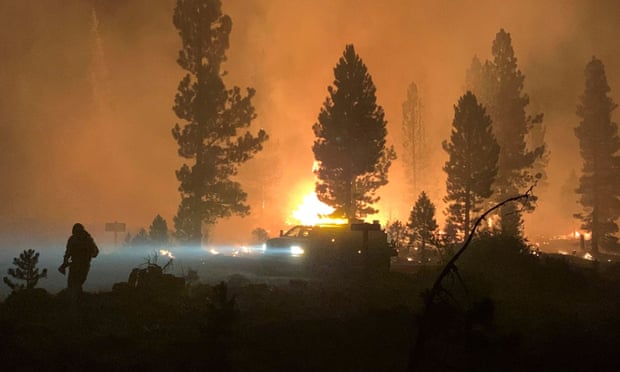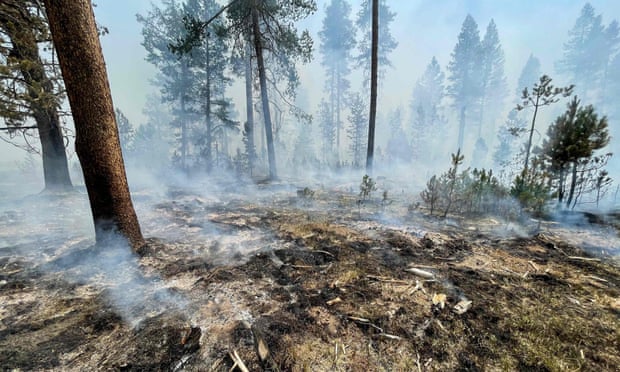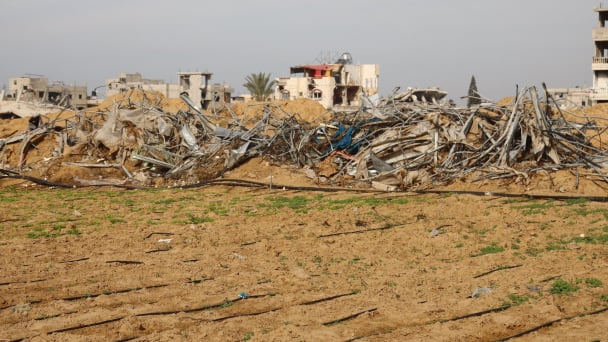June 6, 2025 | 16:05 GMT +7
June 6, 2025 | 16:05 GMT +7
Hotline: 0913.378.918
June 6, 2025 | 16:05 GMT +7
Hotline: 0913.378.918

A firefighter and rig during night operations on Saturday night and Sunday morning at the Bootleg Fire, near Klamath Falls, Oregon. Photo: US Forest Service/AFP
The largest wildfire in the US torched more dry forest landscape in Oregon on Sunday, one of dozens of major blazes burning across the west as critically dangerous fire weather loomed in the coming days.
The destructive Bootleg Fire just north of the California border grew to more than 476 sq miles (1,210 sq km), an area about the size of Los Angeles.
It is one of at least 70 large wildfires are burning across the US west and nearby states.
Erratic winds fed the Bootleg Fire, creating dangerous conditions for firefighters, said Sarah Gracey, a spokeswoman for the firefighting operation. “We’re still facing a lot of weather issues,” she said Sunday. “The winds have been ... hampering our efforts most of the time.”
Authorities expanded evacuations that now affect some 2,000 residents of a largely rural area of lakes and wildlife refuges. The blaze, which is 22% contained, has burned at least 67 homes and 100 outbuildings while threatening thousands more.
At the other end of the state, a fire in the mountains of north-east Oregon grew to more than 17 sq miles (44 sq km) by Saturday night.
The Elbow Creek Fire that started Thursday has prompted evacuations in several small, remote communities around the Grande Ronde River about 30 miles (50 km) south-east of Walla Walla, Washington.
In California, a growing wildfire south of Lake Tahoe jumped a highway, prompting more evacuation orders and the cancellation of an extreme bike ride through the Sierra Nevada on Saturday.
The Tamarack Fire, which was sparked by lightning on July 4, had charred nearly 29 sq miles of dry brush and timber as of Sunday morning.
The blaze was threatening Markleeville, a small town close to the California-Nevada state line. It has destroyed at least two structures, authorities said.
A notice posted on the 103-mile (165-kilometer) Death Ride’s website said several communities in the area had been evacuated and ordered all riders to clear the area.
The fire left thousands of bikers and spectators stranded in the small town and racing to get out.
Kelli Pennington and her family were camping near the town Friday so her husband could participate in his ninth ride when they were told to leave. They had been watching smoke develop over the course of the day, but were caught off guard by the fire’s quick spread. “It happened so fast,” Pennington said. “We left our tents, hammock and some foods, but we got most of our things, shoved our two kids in the car and left.”
Meteorologists predicted critically dangerous fire weather with lightning possible through at least Monday in both California and southern Oregon. “With the very dry fuels, any thunderstorm has the potential to ignite new fire starts,” the National Weather Service in Sacramento, California, said on Twitter.
Extremely dry conditions and heatwaves tied to climate change have swept the region, making wildfires harder to fight. Climate change has made the west much warmer and drier in the past 30 years and will continue to make weather more extreme and wildfires more frequent and destructive.

A smoldering fireline image from the Bootleg Fire on Saturday near Klamath Falls, Oregon. Photo: US Forest Service/AFP
Firefighters said in July they were facing conditions more typical of late summer or fall. California’s Dixie Fire, near the 2018 site of the deadliest US blaze in recent memory, was 15% contained and covered 39 sq miles Sunday. The fire was in the Feather River Canyon, northeast of the town of Paradise, California, and survivors of that horrific fire that killed 85 people watched warily as the new blaze burned.
Officials in Montana identified a firefighter who was seriously burned when flames overtook a crew fighting a small blaze there. Dan Steffensen was flown to a Salt Lake City hospital after the winds shifted suddenly on Friday, engulfing his fire engine near the Wyoming border. A second firefighter escaped without injury and called for help.
There were about 70 active large fires and complexes of multiple blazes that have burned nearly 1,659 sq miles in the US, the National Interagency Fire Center said. The US Forest Service said at least 16 major fires were burning in the Pacific north-west alone.
( The Guardian)

(VAN) With the war ongoing, many Ukrainian farmers and rural farming families face limited access to their land due to mines and lack the financial resources to purchase needed agricultural inputs.

(VAN) Vikas Rambal has quietly built a $5 billion business empire in manufacturing, property and solar, and catapulted onto the Rich List.

(VAN) Available cropland now at less than five percent, according to latest geospatial assessment from FAO and UNOSAT.

(VAN) Alt Carbon has raised $12 million in a seed round as it plans to scale its carbon dioxide removal work in the South Asian nation.

(VAN) Attempts to bring down the price of the Japanese staple have had little effect amid a cost-of-living crisis.

(VAN) Fourth most important food crop in peril as Latin America and Caribbean suffer from slow-onset climate disaster.

(VAN) Shifting market dynamics and the noise around new legislation has propelled Trouw Nutrition’s research around early life nutrition in poultry. Today, it continues to be a key area of research.